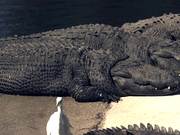Common Glow-Worm
The range of this beetle stretches from Portugal and Britain in the west, right across Europe and Asia to China in the east. It also survives further north than any other firefly, almost reaching the Arctic Circle.
The males are winged, while females are larviforme, wings are missing and they are often twice the size of the males (up to 25 millimetres or 1 inch in length).
Females emit yellowish-green light from the translucent underside of their last three abdominal segments to attract the smaller males. They will glow for 2 hours and then retreat back into their hiding place until the next night (and so up to 10 consecutive nights). The light can be seen by males up to 50 yards away. Virtually all of the energy produced is light; only 2% is heat. The brightness of the glow is used by the males as an indicator of female fecundity. Males are more likely to fly to a brighter female, because it is larger and has more eggs. Once the females have attracted the males with their glow, they mate, lay eggs, and die. The eggs may glow faintly yellow. After 27-45 days the predatory larvae appears, it feed for two or three years on slugs and snails which they inject with a brown toxic digestive fluid, delivered by a series of nips and bites. The slugs and snails are often 200 times the weight of the beetle larva. The larvae are nocturnal, and are most active during moist conditions, when their prey are most active.



















